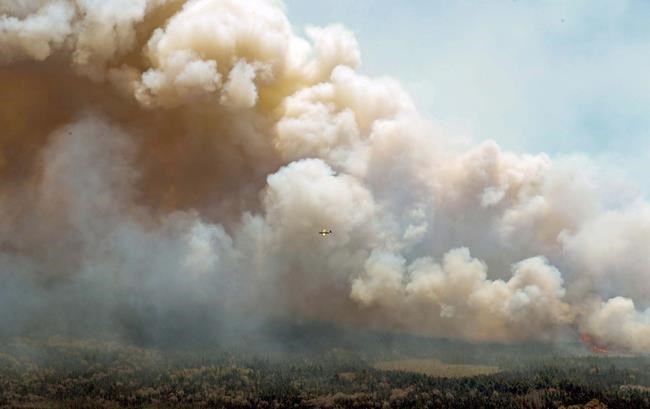WASHINGTON — The United States is happy to help Canada beat back the fearsome start of its wildfire season, officials say — but they are keeping one eye on the calendar, worried about when those resources might be needed closer to home.
There are currently 345 federally co-ordinated firefighters and support personnel operating in Canada, including 13 separate fire suppression crews and a 16-member incident management team.
It's a number that's expected to fluctuate on a daily basis as workers cycle back through the U.S. and then out again to meet additional requests for help, the U.S. National Interagency Fire Center said Friday.
"We are more than willing to provide Canada as many resources as we can as they have done for us in the past," said Jeff Arnberger, chair of the agency's National Multi-Agency Co-ordinating Group.
"We have been fortunate to have a slow start to our fire year nationally. However, as we head into traditionally busy months of summer, we must also be prepared for wildfires in the U.S."
A total of 649 U.S. personnel have been cycled through Canada since early May as the country contends with a wildfire season that started far earlier than usual and is expected to land in the history books before it's all over.
That number doesn't include state-level resources that are also assisting, the agency says: provinces and states have numerous regional "compacts" to allow them to share firefighters and equipment without needing to make a federal request.
More than 100 firefighters and support workers have been sent separately to Alberta, Nova Scotia and Quebec so far this year, along with four airtankers from Alaska and Washington state.
A 17-person suppression crew with members from Connecticut, New York, Maine and New Hampshire was also assembled to help Nova Scotia, and a hand crew is currently being put together to send to Quebec.
Forest fires in Canada wouldn't normally generate many headlines in the U.S., but the smoke they've been producing has been drifting south, triggering air quality alerts and sending social media into a feeding frenzy.
"Welcome to hell, New York," declared a Times Square billboard for the new video game Diablo IV — a product far less frightening than the smoggy, grey-orange sky in the background.
"Eh!pocalypse now," read the front page of Thursday's edition of the tabloid New York Post, above an all-caps headline urging readers to "Blame Canada!"
The smoke triggered purple and maroon air quality alerts — "very unhealthy" and "hazardous," respectively — throughout the mid-Atlantic region Thursday, including in Baltimore, Philadelphia and Washington, D.C.
But cooler temperatures and a stiff breeze helped mitigate the risk Friday as alerts gradually began to ease back to more manageable levels.
The Canadian Interagency Forest Fire Centre is in constant contact with its U.S. counterpart and is going to need more help for the next little while, said spokesperson Jennifer Kamau.
"We are in continued conversations with our American partners and do have a tentative (mobilization) scheduled for next week," Kamau said, though numbers won't be available until the plan is confirmed.
It's still too soon to know what resources might be needed in the coming weeks, or indeed whether Canada will be asked to return the favour anytime soon.
"These situations can evolve rapidly," Kamau said. "It would be hard to tell what the fire situation and availability will be like if or when a need arises from one of our international partners."
To be sure, the smoke has been hard not to notice in the U.S. capital, where President Joe Biden has repeatedly cited the pollution as evidence of encroaching climate change and urged residents to take precautions.
Republicans, on the other hand, are using Canada's fire season to argue for additional federal resources, as well as a more aggressive approach to forest management.
"It is a sobering reminder that we must manage our forests to make them more resilient to catastrophic fires," Sen. John Barrasso (R-Wyo.) told a hearing Thursday of the Senate energy committee where he's ranking member.
More than 32,000 square kilometres of wildlands burned each year between 2017 and 2022, Barrasso said — double the average annual amount of damage in the 1990s.
The cost of fire suppression climbed to more than $4 billion in 2021, up from an annual average of $2.86 billion during the previous five years, he added.
"It is unsustainable to keep throwing more and more money and resources at suppression without dramatically increasing mitigation," Barrasso said. "Waiting for our forests and communities to burn is not a defensible strategy."
Both sides, however, appear to agree that more wildfires are in North America's future.
"As climate change accelerates, difficult-to-suppress wildfires are becoming our new normal. There is no more 'wildfire season,' it’s a year-round threat," said Sara Kangas, a spokesperson for the group American Forests.
The Biden administration has spent nearly $20 billion on fire prevention and recovery to date through the Bipartisan Infrastructure Law and the Inflation Reduction Act, Kangas added.
"We're working hand-in-hand with the administration and its agencies to implement climate-adapted forest management as quickly as possible through best available science," Kangas said.
"Workforce capacity and nursery and seedling capacity will continue to be problems both in preventing catastrophic wildfires and in recovering from them."
This report by The Canadian Press was first published June 9, 2023.
James McCarten, The Canadian Press




